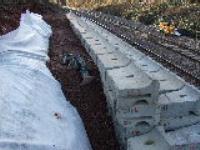 Add My Company
Add My Company
Sign In

The need for speed was required for the replacement of a retaining wall and platform following station damage at Moston Station, on the outskirts of Manchester.
In 2015, a 50m section of platform 2 was heavily damaged when loose equipment from a passing freight train smashed into it. The damaged area was closed off and Network Rail design engineer, Alex Evans, took advantage to bring the Victorian station’s platform up to modern standards, began plans for a rebuild.
With train operating company, Northern Rail (a key stakeholder) expecting to run longer trains through the station from April 2019, the rebuild team had to come up with a solution which could be undertaken at speed. This meant scrapping the initial design by external consultants in favour of a scheme that avoided much of the track possession they had proposed.
“The old design was all possession work. The plans were to excavate down right next to the track and cast a strip footing continuously all the way down,” says Mr Evans. Situated within a 9m deep soil cutting; the original platform of Moston Station was a concrete structure that retained a granular fill. It incorporated an old brick retaining wall at the rear, which used to retain the cutting slope behind it. Network Rail’s in-house civil engineering team were tasked with redesigning and building the area in a short, eight-month programme. Their design and construction method centered on removing the need to use the track for plant.
Mr Evans explained: “Normally, the traditional method of construction would mean transporting material via the railway, this means the railway needs to be closed so working hours are restricted to midweek nights and Saturday evenings, which for this area would mean around six hours per shift. The access pointed for the plant is more than 1.6km away and the speed limit is 8km/h, so once a machine had got onto the railway and made its way to the site, an hour would have been lost. This would have reduced the working time to around four hours per shift.
The new design meant that most of the work could be undertaken while the railway was open, with the new platform construction excavating the toe of the cutting to create room for a new platform and replacing the old brick retaining with a new precast concrete one. Mr Evans added, “There were some possessions for some elements of the work but these activities were achievable in the possession windows, whereas the alternative design was more complicated as it involved significant temporary
work, which posed a risk to track quality and were time-consuming.”
Network Rail overcame the problem of where to place the construction equipment serving the site by undertaking an analysis of the stability of the cutting’s slope, which showed that it would be stable during construction while the toe was removed and the Marshalls CPM Redi-Rock retaining wall installed.
Network Rail works delivery civils senior design engineer Pip Stokes explains: “The original design was based on the track and doing things from there, whereas our innovation was to do some slope stability calculations to prove that plant could work mid slope. The team looked at a flat section of the slope where machines could potentially sit, with calculations showing that it could hold the machinery.
Installation of interlocking precast concrete Redi-Rock blocks from Marshalls CPM retained the slope giving a mass gravity retaining wall.
Mr Evans added, “There are some possessions for some elements of the work but these activities were achievable in the possession windows, whereas the alternative design was more complicated as it involved significant temporary work, which posed a risk to track quality and were time-consuming.”
Mr Evans said; “The existing retaining wall at the rear of the platform retained the toe of the cutting. We proposed removing the retained material to the rear of the wall before deconstructing the wall; this was an example of making sure we removed the lateral pressure on the wall without undermining it. The construction sequence was considered
throughout.”
Network Rail’s in-house civil engineering team, avoided the need for a lengthy procurement process and undertook the construction work. Network Rail works delivery programme manager Ben Campbell said: “One big programme saving was in procurement time. Appointing an external designer and an external contractor as a rule of thumb would have maybe taken two months each. So even if the designer had come up with exactly the same solution to ours and the deliverer had worked in exactly the same way as out in-house delivery had worked, you could add an extra four months to the programme.”
“The other advantage was that when the design was 95% finished in terms of effort, we were able to issue drawings to our deliverers in a way that we would not be able to if we were an external designers or they were an external deliverer. We were able to show them under the covers before we would otherwise, and the advantage of that was that they could do detailed planning on the delivery side earlier and book possessions and book long lead items.”
The project has been completed, on both time and on budget. Mr Evans said; “This project meant so much to me as it showed what we can achieve when design and delivery work hand-in-hand and support each other through the process.”
For more information please visit https://www.cpm-group.com/products/retaining-walls/ or email redi-rock@marshalls.co.uk
For more information on Redi-Rock walling used for rebuild needing speed of installation talk to Marshalls CPM
Enquire Now
List your company on FindTheNeedle.

